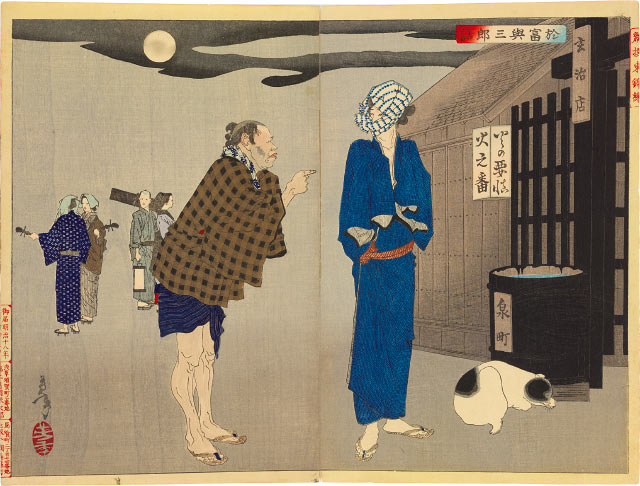

Tsukioka Yoshitoshi
1839-1892
New Selection of Eastern Brocade Pictures: The Story of Otomi and Yosaburo
(Shinsen axuma nishiki-e: Otomi Yosaburo [no] hanashi)
signed Yoshitoshi, with artist's seal Yoshitoshi, carved by Horiko Wada, and publisher's date and address seal Meiji juhachinen [cropped]; [Tokyo Nihonbashi] Bakurocho Nichome 14-banchi, shuppanjin Tsunashima Kamekichi (Meiji 18 [1885]) of Tsujiokaya Kamekichi of Kinkido and Tosendo
oban tate-e diptych 14 1/8 by 18 7/8 in., 36 by 48 cm
Kirare ('scar-faced') Yosaburo, on the right with a tie-dyed scarf concealing his mutilated face, and stands beside his criminal collaborator Komori ('bat', for the birthmark on his cheek) Yasu outside the house where Yosaburo's former lover Otomi is hiding. This episode is taken from a series of kabuki dramas commonly referred to as Scar-Face Yosa (Kirare Yosa) which tell the story of Yosaburo and Otomi's ill-fated affair. The bat-shaped birth mark, as well as the combination of Yosaburo's scarf and neck scarring, would have made this subject instantly recognizable to a fan of kabuki theater.
As the tale unfolds, Yosaburo was a handsome youth who fell in love with the beautiful Otomi, a gangster's mistress. When the gangster learned of their affair, he mutilated Yosaburo and tried to kill Otomi, who escaped to the seaside and was thought to have drowned herself in despair. Distraught at his misfortune and Otomi's death, Yosaburo partnered with Yasu and turned to a life of crime. She survived, however, and for three years peacefully convalesced in the house depicted in the composition with the kindly merchant Tazaemon. Unfortunately, this calm was not to last, as Yosaburo and Yasu, ignorant of Otomi's survival, conspired to extort the merchant. This foreboding composition depicts the pair planning their crime, just meters away from Yosaburo's long lost lover.
Published:
Highlights of Japanese Printmaking: Part Five - Yoshitoshi, Scholten Japanese Art, New York, 2017, cat. no. 90
References:
Roger Keyes, Courage and Silence, 1983, p. 468, no. 479.1
Shinichi Segi, Yoshitoshi the Splendid Decadent, 1985, p. 102, no. 111
Eric van den Ing & Robert Schaap, Beauty and Violence, 1992, p. 76, no. 55.1
Akita Museum of Modern Art, Tsukioka Yoshitoshi: The Last Ukiyo-e Artist of Genius, 1999, p. 32, no. 106
John Stevenson, Yoshitoshi's One Hundred Aspects of the Moon, 2001, p. 42. no. 47
Arendie Herwig & Henk Herwig, Heroes of the Kabuki Stage, 2004, pp. 306-311 (re: story)
Amy Reigle Newland & Chris Uhlenbeck, Yoshitoshi: Masterpieces from the Ed Fries Collection, 2011, p. 127, no. 93
Ota Memorial Museum of Art, Tsukioka Yoshitoshi: 120th Memorial Retrospective, 2012, p. 126, no. 186
Yuriko Iwakiri, Yoshitoshi, 2014, pp. 126-127, no. 184
(inv. no. 10-4604)
price: $3,000






